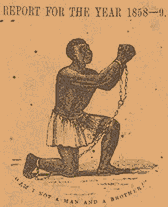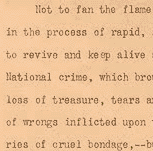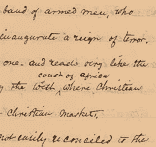Fugitive Slave Law |
|
| North to Canada | |

Mission to Fugitive Slaves in Canada: Being a Branch of the Operations of the Colonial Church and School Society . . . 1858-9. [London]: Society's Offices, 1859. Pamphlet. Rare Book and Special Collections Division. (3-4a) |

Mission to Fugitive Slaves in Canada: Being a Branch of the Operations of the Colonial Church and School Society . . . 1858-9. [London]: Society's Offices, 1859. Copyprint. Rare Book and Special Collections Division. (3-4b) |
|
In the wake of the Fugitive Slave Law of 1850, which forced Northern law enforcement officers to aid in the recapture of runaways, more than ten thousand fugitive slaves swelled the flood of those fleeing to Canada. The Colonial Church and School Society established mission schools in western Canada, particularly for children of fugitive slaves but open to all. The school's Mistress Williams notes that their success proves the "feasibility of educating together white and colored children." While primarily focusing on spiritual and secular educational operations, the report reproduces letters of thanks for food, clothing, shoes, and books sent from England. This early photograph accompanied one such letter to the children of St. Matthew's School, Bristol. |
|
| The Fugitive Slave Law of 1850 | |
 The Fugitive Slave Law. Hartford, Connecticut, 1850. Rare Book and Special Collections Division. (3-5) |
This controversial law allowed slave-hunters to seize alleged fugitive slaves without due process of law and prohibited anyone from aiding escaped fugitives or obstructing their recovery. Because it was often presumed that a black person was a slave, the law threatened the safety of all blacks, slave and free, and forced many Northerners to become more defiant in their support of fugitives. S. M. Africanus presents objections in prose and verse to justify noncompliance with this law. |
| Anthony Burns--Capture of A Fugitive Slave | |
|
This is a portrait of fugitive slave Anthony Burns, whose arrest and trial in Boston under the provisions of the Fugitive Slave Act of 1850 incited riots and protests by white and black abolitionists and citizens of Boston in the spring of 1854. The portrait is surrounded by scenes from his life, including his sale on the auction block, escape from Richmond, Virginia, capture and imprisonment in Boston, and his return to a vessel to transport him to the South. Within a year after his capture, abolitionists were able to raise enough money to purchase Burns's freedom. |

Anthony Burns. Boston: R. M. Edwards, 1855. Wood engraving with letterpress. Prints and Photographs Division. Reproduction Number: LC-USZ62-90750 (3-9) |
Growing Sectionalism |
Antebellum Map Showing the Free and Slave States |
 Reynolds's Political Map of the United States . . . . New York: Wm. C. Reynolds, 1856. Geography and Map Division. (3-20) |
The growing sectionalism that was dividing the nation during the late antebellum years is documented graphically with this political map of the United States, published in 1856. Designed to portray and compare the areas of free and slave states, it also includes tables of statistics for each of the states from the 1850 census, the results of the 1852 presidential election, congressional representation by state, and the number of slaves held by owners. The map is also embellished with portraits of John C. Fremont and William L. Dayton, the 1856 presidential and vice presidential candidates of the newly organized Republican Party, which advocated an anti-slavery platform. |
| Distribution of Slaves | |
|
Although the Southern states were known collectively as the "slave states" by the end of the Antebellum Period, this map provides statistical evidence to demonstrate that slaves were not evenly distributed throughout each state or the region as a whole. Using data from the 1860 census, the map shows, by county, the percentage of slave population to the whole population. Tables also list population and area for both Southern and Northern states, while an inset map shows the extent of cotton, rice, and sugar cultivation. Another version of this map was published with Daniel Lord's The Effect of Secession upon the Commercial Relations between the North and South, and upon Each Section (New York, 1861), a series of articles reprinted from The New York Times. |

Adolph von Steinwehr. Map Showing the Distribution of Slaves in the Southern States, [n. p., n. d.]. Printed Map. Geography and Map Division. (3-14) |
Militant Abolition |
John Brown's Raid |

Address of John Brown . . . Sentence of Death; For his heroic attempt at Harpers Ferry. . . . Boston: C.C. Mead. Broadside. Rare Book and Special Collections Division. (3-6) |
More than twenty years after the militant abolitionist John Brown had consecrated his life to the destruction of slavery, his crusade ended in October 1859 with his ill-fated attempt to seize the federal arsenal at Harpers Ferry in western Virginia. He hoped to take the weapons from the arsenal and arm the slaves, who would then overthrow their masters and establish a free state for themselves. Convicted of treason and sentenced to death, Brown maintained to the end that he intended only to free the slaves, not to incite insurrection. His zeal, courage, and willingness to die for the slaves made him a martyr and a bellwether of the violence soon to consume the country during the Civil War. |
| Frederick Douglass on John Brown | ||

Frederick Douglass. "A Lecture on John Brown." Typescript, 1860. Frederick Douglass Papers, Manuscript Division. (3-8a) |
The friendship of Frederick Douglass and John Brown began in 1848, when Douglass visited Brown's home in Springfield, Massachusetts. Brown confided to Douglass his ambitious scheme to free the slaves. Over the next eleven years, Brown sought Douglass's counsel and support. |

"A Lecture on John Brown." Autograph corrections and drafts, 1860. Frederick Douglass Papers, Manuscript Division. (3-8b) |
|
In August 1859 Brown made a final plea to Douglass to join the raid on Harpers Ferry. Douglass refused. After Brown's capture, federal marshals issued a warrant for Douglass's arrest as an accomplice. Douglass fled abroad. When he returned five months later to mourn the death of his youngest daughter Annie, he had been exonerated. Douglass wrote this lecture as a tribute to "a hero and martyr in the cause of liberty." |
||
"The Book That Made This Great War" |
|
| Harriet Beecher Stowe's Mighty Pen | |

Copyprint. Published by Johnson, Fry & Co., 1872, after Alonzo Chappel. Prints and Photographs Division. Reproduction Number: LC-USZ62-10476 (3-18) |
Harriet Beecher Stowe is best remembered as the author of Uncle Tom's Cabin, her first novel, published as a serial in 1851 and then in book form in 1852. This book infuriated Southerners. It focused on the cruelties of slavery--particularly the separation of family members--and brought instant acclaim to Stowe. After its publication, Stowe traveled throughout the United States and Europe speaking against slavery. She reported that upon meeting President Lincoln, he remarked, "So you're the little woman who wrote the book that made this great war." |
| Uncle Tom's Cabin--Theatrical Productions | |
|
This poster for a production of Uncle Tom's Cabin features the Garden City Quartette under the direction of Tom Dailey and George W. Goodhart. Many stage productions of Harriet Beecher Stowe's famous novel have been performed in various parts of the country since Uncle Tom's Cabin was first published as a serial in 1851. Although the major actors were usually white, people of color were sometimes part of the cast. African American performers were often allowed only stereotypical roles--if any--in productions by major companies. |
 Palmer's Uncle Tom's Cabin Co., 1882, no. 11 Buffalo, N.Y.: Courier Litho. Co., ca. 1899. Prints and Photographs Division. Reproduction Number: LC-USZC4-6171 (3-10) |
|
Exhibit Sections: Slavery | Free Blacks | Abolition | Civil War | Reconstruction Booker T. Washington Era | WWI-Post War | The Depression-WWII | Civil Rights Era | |
African American Odyssey Introduction | Overview | Object List | Search